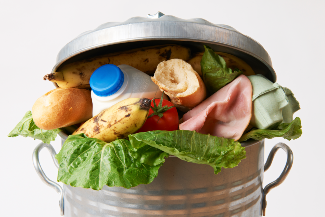Member State Page : Denmark
Last updated on the 16/05/2025

Per capita: 252,4 kg in 2022
In total: 1.497.958 tonnes in 2022

Primary production: 116.629 tonnes in 2022
Processing and manufacturing: 695.475 tonnes in 2022
Retail and other distribution of food: 100.355 tonnes in 2022
Restaurants and food services: 75.634 tonnes in 2022
Households: 509.865 tonnes in 2022

National target: Reduce the amount of food waste across the food supply chain
Target
The target of the Government of Denmark is to reduce the amount of food waste across the whole food supply chain.
Furthermore, ONE\THIRD has launched the voluntary agreement Denmark against Food Waste where food business operators along the entire food value chain can commit to monitoring and reporting their food waste data – working towards reducing food waste by 50% by 2030.
Measure
The Danish Environmental Protection Agency is in charge of measuring the amounts of food waste generated across the entire value chain (i.e. the five sectors mentioned above). All measurements follow the common methodology set out in the Commission Delegated Decision (EU) 2019/1597.
The figures above, presenting sectoral food waste data, show results from studies or calculations across the value chain.
The figures for food waste in the primary production, processing, and manufacturing sectors in 2022 is based on surveys, interviews, and statistical data.
The figure for food waste in the retail sector in 2022 is based on a calculation.
The figure for food waste in the restaurant and food services sectors in 2022 is based on compositional analysis and national waste data.
The figure for household food waste in 2022 is based on a calculation.
Act
Stakeholder involvement and focus on regulatory simplification:
1) Think Tank on Prevention of Food Loss and Food Waste - ONE\Third
2) Innovation conference
3) Working group on regulatory barriers to reducing edible parts of food waste
More knowledge on measures, effect and reduction potential
4) Denmark against Food Waste - voluntary agreement for food producers and retailers
5) Research: Establishing evidence for reduction effects on edible parts of food waste
6) Review of historical data and setting sub-targets
7) Public Kitchens against Food Waste
8) The Green Development and Demonstration Programme (GUDP)
Information and accessibility of tools
9) Campaign for food waste awareness and behaviour change
10) Access to knowledge and tools
11) Support for transport costs incurred by food organisations
12) National Food Waste Day
International engagement
13) The Champions 12.3 coalition
14) Strategic sectoral collaboration
15) Food legislation in neighbouring EU countries
In 2019, the Danish Government established the Think Tank on Prevention of Food Loss and Food Waste – ONE\THIRD and launched the Denmark against Food Waste voluntary agreement, where food business operators along the food value chain can commit to monitor and report their amounts of food waste thereby contributing to achieving the target of reducing food waste by 50 % by 2030.
The aim of ONE\THIRD is to form partnerships between stakeholders from food businesses, non-governmental organisations, research institutions and public authorities in order to raise awareness, promote initiatives, share science-based knowledge and exchange best practices concerning food loss and waste reduction initiatives. The Think Tank consists of a board and around 30 members recruited from the public and private spheres, representing the whole food supply chain.
The work of ONE\THIRD is guided by the following five objectives:
- Support the civil society's battle against food loss and food waste;
- Contribute to general business opportunities;
- Offer insights on how to overcome barriers to prevent food losses and food waste;
- Ensure that data collection and impact assessments are improved; and
- Cooperate with foreign partners on know-how and sharing of experiences.
To assist retailers in reducing food waste, The Foodwastehunters 2.0. launched in 2021 with the purpose of reducing food waste in the Danish retail. Retailers were offered assistance from a so-called “food waste hunter” that provides guidance, methods and recommendations to reduce food waste in a hands-on and practice-based manner. The project resulted in a practical guide to reduce food waste in retail business aimed at the people on the floor.
The Danish Ministry of Food, Agriculture and Fishery has established a task force on food loss and waste in 2023. This task force will provide recommendations on how to simplify donation regulation regards FLW, in order to make it easier for Danish food companies to implement initiatives to prevent FLW.
The Danish Veterinary and Food Administration carried out a three-month inspection and guidance campaign in 2023. The campaign targeted retail businesses that receive food donations. Food waste initiatives are supported and highly appreciated with the prerequisite that food safety is not compromised. Thus, the purpose of the campaign was dual; to guide food waste organisations, and to check the organisations’ compliance with food safety legislation with focus on traceability, allergen labelling and facilities for hygienic washing and drying of hands. The results of the campaign showed a high level of regulatory compliance, but that there is still a need for guidance on donations.
On the conversion to organic food of professional public kitchens, studies commissioned by the Danish Veterinary and Food Administration have shown that kitchens have not only been able to increase the procurement of organic products, but at the same time they have reduced food waste significantly. The organic price premium is partly covered by reducing food waste, allowing more organic meals without an increase in operating budgets.
In order to raise awareness on the issue of food waste, Denmark launched a National Food Waste Day celebrated yearly on 29th of September (aligned with the UN International Day of Awareness of Food Loss and Waste). The aim is to give further visibility to civil society initiatives and to inform and instruct citizens about how to save food.
Several consumer information campaigns on the meaning of date marking have been carried out and extensive guidelines on the meaning, understanding and handling of date markings have been established. Aarhus University has conducted several studies on date marking with the aim of improving consumer understanding of date marking.
The report ‘Consumer food waste in Denmark’ (2018) published by the Aarhus University offers a better understanding of consumers’ perceptions and behaviours related to food waste, in order to inform measures to limit such waste. The report ‘Consumer behaviour towards food waste in families with children’ (2021) examined food-related practices and food waste drivers in families with children, and suggested hands-on tools to help families reduce their food waste. Two of the tools were used in a consumer campaign in 2022 and again in 2024. .
Several food business sectors have developed guidance on food waste reduction and some businesses have introduced additional training for staff, including on the possibility to donate surplus food.
Research and innovation are key in order to define and implement initiatives that ensure an optimal use of food at each stage of the food supply chain, focusing on the best destination for surplus food and a maximal valorisation of edible food resources. Denmark has invested DKK 15 million over 3 years in research on Food Waste, among other:
- · Action Catalogue for Reducing Food Waste, including food loss, with a focus on the five different stages of the food value chain.
- · Analysing the cause of food waste in households, including factors related to cooking, shopping, planning, etc., as well as among different segments such as families with children.
